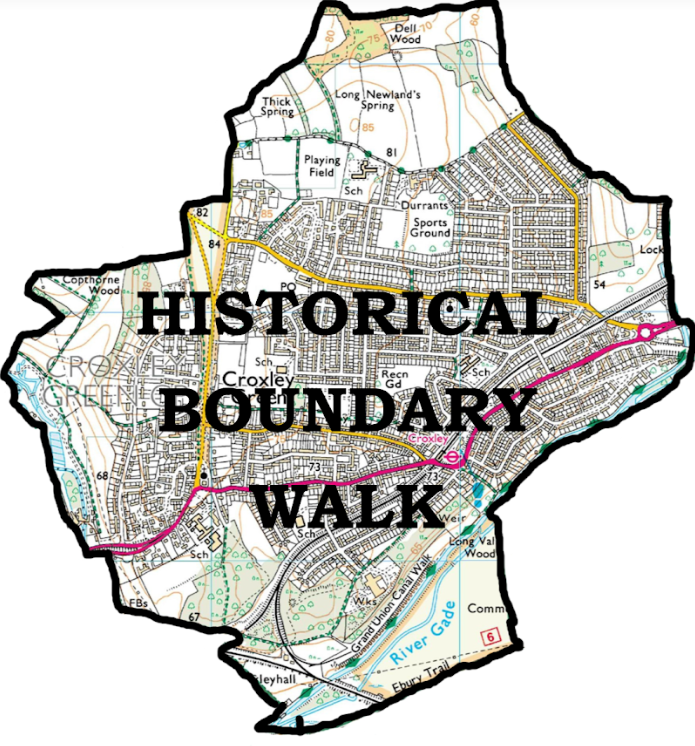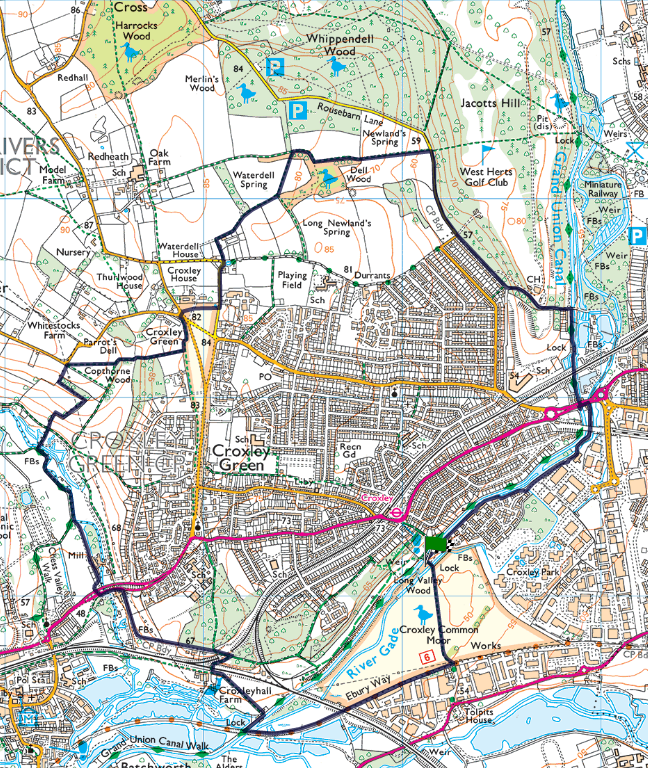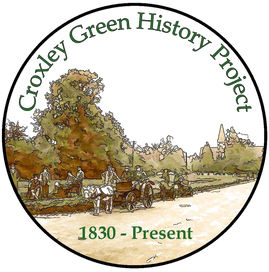Step into Croxley’s past……
The Croxley Green Boundary Walk (6.3 miles)
Start at the top of Little Green Lane with your back to the Green and Croxley House on your left. Walk down the lane past Killingdown Farm to Little Green. Continue straight ahead, past Waterdell House. At Coachman’s Cottage take the very narrow path (can be muddy) between the two properties and at the end turn right to follow the track along the edge of a field.
Continue to the edge of the wood and go straight on with the wood on your left. When you reach some trees on your right, turn sharp left to cross the field and go through the gap in the trees. You will see two gates ahead. Do not enter the wood but turn right along the main track, keeping Dell Wood on your right. Go through the steel gate and continue downhill across the field and through the kissing gate.
Turn right onto Rousebarn Lane. Walk down the lane (occasionally flooded) and carry on along the pavement when you reach the houses. Ignore the left turn to West Herts Golf Club and take the next left, towards Gade Bank. The lane climbs up quite steeply and then drops down towards the canal.
Just before the canal, turn right in front of the row of houses and then right onto the tow path. With the canal on your left, pass the lock and walk under the railway bridge and the road bridge until you reach some steps on your right. Go up to the road and turn right. Walk down the road over the canal and turn right into Beggars Bush Lane. Continue to the end of the lane and turn right onto Blackmoor Lane.
At the weir, cross the road to enter the Byewaters Estate and walk alongside the canal to lock 79. Turn left over the wooden footbridge and through the metal kissing gate onto Common Moor. Follow the wide path across the moor. Go through the gate at the end and turn right onto the Ebury Way towards Rickmansworth.
After about half a mile, cross the metal bridge over the canal and go down the steps immediately to your left. Turn left along the tow path, with the canal on your right. At the lock, turn left just after Lot Mead Lock House and walk up towards the wood.
At the top of the path turn left near Croxleyhall Farm and then turn right over the bridge which crosses the Metropolitan Line. Continue up the hill to the T- junction and turn left. Follow the main track past the houses and all the way to the main road (Scots Hill).
Turn left along the pavement past Scotsbridge House and cross the road with extreme care. Walk up the drive opposite towards Scotsbridge Mill but without entering the car park. With the skatepark on your left and the hedge on your right, continue to the rugby field and walk along the edge of the field. After a metal barrier the path joins the River Chess.
Keeping the river on your right, walk along the bank until you reach a footbridge. Cross the bridge and walk up the path to a crossroads of paths. * Continue straight ahead into the field. Keeping the trees on your right, walk around three sides of the field and then uphill towards the road. Follow the sign for path no.7 to The Green, crossing the field to the corner of a wood. Continue into the wood to reach a flight of wooden steps. Climb the steps and follow the track all the way back to The Green.
* If the path is fenced off here, turn RIGHT and continue until the next path on the LEFT and take this path uphill along the boundary between the two fields. This path eventually levels out and then dips down to join the original route at the corner of the wood. Continue into the wood to reach a flight of wooden steps. Climb the steps and follow the track back to The Green.
1.Croxley House
Croxley House dates from 1770 when it was built for Thomas Lord Hyde, later Earl of Clarendon. A stone wall enclosed the 14 acre site and a well was sunk in the garden. It was then purchased by Humphrey Cornwall Woolrych in 1794 and various members of the Woolrych family lived here until the 1920s. They then moved into Parrotts Farm, which they had owned since 1799. During WWII, Croxley House was leased to St Dunstans for servicemen who had been blinded in action. A document has recently come to light in the US which reveals that Croxley House was the initial venue for the joint Anglo-American preparations for D-Day: Operations Marathon and Overlord. Secret meetings were held here throughout April 1944. In 1949 the house was purchased by the Women’s Royal Voluntary Service (WRVS). It later became a residential home for the elderly.
2 Rousebarn Lane
Listed as Rowsbarn as early as 1766, this lane forms the north eastern boundary of Croxley Green. The road just after the turning for West Herts Golf Club used to lead up to Cassiobridge House. Built in the late 18th century, the house stood in large grounds, incorporating a poultry farm and orchards. The main entrance was on Baldwin’s Lane. In 1939 the house was bought by the Associated British Film Distributors as a storage depot before being demolished in 1965. The land has recently been redeveloped to house Croxley Danes School but the lime trees were saved. Rousebarn Lane was closed to through traffic in 1993.
3 The Canal
The Grand Union Canal opened in 1805, linking the industrial Midlands to the London markets. Parts of Common Moor and Lot Mead had been sold by Gonville and Caius College to the canal company as Croxley lay on the planned route. Of the 100 locks on the canal, two are within Croxley, locks 79 and 80. The canal would bring huge change to Croxley. Coal could be transported by barge directly to the mills built along the canal.
4 Dickinson’s Mill
John Dickinson already owned several paper mills in the area when he acquired some land adjoining Common Moor. It was ideal, as the nearby River Gade could be diverted as a source of power and the canal system provided a reliable transport system for raw materials. The new mill was built and began production in 1830. It included a grand Egyptian façade, built in response to the objections raised by Lord Ebury whose mansion at Moor Park had a view of the site! The coal barges could be moored directly alongside the huge mill, which stood on what is now the Byewaters estate. The arrival of the mill in Croxley attracted workers from all over the surrounding area and led to a rapid rise in the population. Cottages were built near the canal and later at Mill Square (now Dickinson Square) to house the mill workers and as the population expanded so did the village, with lots more houses and shops being built on New Road from the 1880s. Croxley Script paper became known the world over and the Dickinson offices were all named Croxley House. Production grew and by the 1960s the Croxley mill housed six paper making machines and employed 1000 people.
5 Metropolitan Line station
Although not directly on the route, the tube station has been so significant in the development of Croxley Green that it is included here. In 1912 an LNWR branch line from Watford to Cassiobridge had opened with a station named Croxley Green. Later the same year, permission was given for a spur to be constructed from the Metropolitan Line (already running to Chesham) at Moor Park through Croxleyhall Wood to Cassiobury Park in Watford. Work was delayed until after WW1 but completed in 1925 with the opening of Croxley Met Station. The name was changed from Croxley Green to avoid confusion with the older station at the bottom of Watford Road! The following decade saw a huge expansion in house building, as Croxley became officially part of “Metroland”.
6 Long Valley Wood
This area was the site of gravel excavation from the early 1900s. The gravel was extracted by hand and transported by railway for the building trade. It formed part of the Rickmansworth Sand and Gravel Company, founded in 1902. The site was later bought by London Underground transport and used as a landfill site for the spoil from the Neasden depot. Known as “Croxley Tip”, the area was eventually left to nature and became overgrown, mainly by buddleia. Then in 2004, London Underground Ltd made an application to use the land for a new depot. This would have blighted this part of Croxley with night trains, damage to ancient woodland, closure of footpaths, loss of wildlife habitat and loss of Green Belt land. After a public inquiry in 2007, a successful bid by the Keep Croxley Green Group secured Long Valley Wood as a public open space and in 2008 the Buddleia Walk was awarded Village Green status.
7 Common Moor
Surrounded by development, Common Moor comprises 40 hectares of historic grassland on the flood plain of the River Gade. Centuries of grazing have helped preserve the diversity of plant life and led to its designation as a Site of Special Scientific Interest (SSSI) and Local Nature Reserve. Cattle are still brought in regularly to maintain the grassland, as without them it would become dense woodland. More than 250 varieties of plants have been identified here. The moor and river are also home to many birds, small mammals, insects and fish.
8 The Ebury Way
This path is 3.5 miles long and links Watford and Rickmansworth along the route of a former railway. The Watford and Rickmansworth Railway opened in 1862 and was the shortest of Hertfordshire’s branch lines. An extension to Uxbridge was planned but never built. Indeed, Lord Ebury, who lived at Moor Park and was Chairman of the Watford and Rickmansworth Railway Company, had envisaged a railway linking east and west Hertfordshire. As it was, the line had to cross the rivers Chess, Gade and Colne as well as the Grand Union Canal before arriving at the new Rickmansworth Station at Church Street. There was plenty of goods traffic, with the railway serving Watford Power Station, Goodyear Tyres, Dickinson’s paper mill (which had its own siding until 1980) and the watercress beds. The line was electrified in 1927 but passenger traffic declined with the opening of the Metropolitan Line to Amersham in 1887 and Croxley Station in 1925. Eventually the line closed in 1951.
9 Croxley Hall Farm
Hertfordshire became famous for watercress during the 1800s. The many springs, filtered through gravel made it ideal growing country. The Sansom family of Croxley Hall Farm had a thriving watercress business by the 1930s and Charles H Sansom was at one time chairman of the National Watercress Growers Association. The railway was essential as watercress perishes quickly. The cress was dispatched daily to London and elsewhere via the “Watercress Express”. It was even used in the dining car on the royal train to Balmoral! During WWII it was in demand as a cheap and healthy food and two German prisoners of war were employed at Croxley Hall to help maintain production.
10 The Great Barn
The oldest building in Croxley, the Great Barn dates from about 1400 when Croxley was part of the Manor of St Albans. The monks used the farm to grow grain. In 1557 it was sold to Dr Caius of Gonville College, Cambridge and remained in their ownership until 1972 when it was donated to Hertfordshire County Council and renovated. The barn was transferred to the Croxley Great Barn Foundation in 2012.
11 Scotsbridge and The River Chess
Scotsbridge Mill dates from the late 17th century. It began as a fulling (wool cleaning) and corn mill but was converted into a paper mill in 1757. In 1914 it was producing photographic paper and then it was bought by a postcard company. MGM took it over in 1927, using the mill to produce acetate for the film industry. The mill even featured in some films and became the UK headquarters of MGM until 1973 when it was used by Cygnet Press. The mill fell into disrepair but was renovated and has been used as a restaurant since 1989. This stretch of the River Chess was the location of the watercress beds, farmed by the Dorrofield family. The family built Fishery Cottage, on the higher bank of the river. The cottage was built against an old chimney stack which was the remains of the Pest House, once used to isolate smallpox patients!
12 The Green
The Green has a wealth of history to explore at the end of your walk. Killingdown Farm, Little Gillions, Dugdales, Lovatts, Rose Cottage and Hollowtree Farm all have interesting histories. The oldest building is Providence Hall, dating back to the 16th century. The Orchard, once 12 acres in size and incorporating what is now Yorke Mead School, used to attract visitors from miles around to its Cherry Sundays. Before World War Two, there was a cricket pitch and it was common to see cows being driven across The Green to the milking parlour on Scots Hill. Always at the heart of the community, The Green has been the setting for many local events. Coronations and Jubilees were all celebrated with processions, sports matches, firework displays and tree planting ceremonies. Most of the commemorative trees remain, with plaques for each occasion. May Day festivities began in the 1920s and gave rise to the annual Revels which continue today.
13 Parrotts Farm
As well as purchasing the land for Croxley House, in1794 Humphrey Cornwall Woolrych purchased Parrotts Farm in 1799. The many tenants and owners who had previously held this land included members of the ‘Pairetts’ family. A succession of Woolrych family members included Humphrey Cornwall Woolrych in 1816, Humphry William Woolrych, Sergeant-at-law, and in 1871 William Richard Woolrych.
Continue to the edge of the wood and go straight on with the wood on your left. When you reach some trees on your right, turn sharp left to cross the field and go through the gap in the trees. You will see two gates ahead. Do not enter the wood but turn right along the main track, keeping Dell Wood on your right. Go through the steel gate and continue downhill across the field and through the kissing gate.
Turn right onto Rousebarn Lane. Walk down the lane (occasionally flooded) and carry on along the pavement when you reach the houses. Ignore the left turn to West Herts Golf Club and take the next left, towards Gade Bank. The lane climbs up quite steeply and then drops down towards the canal.
Just before the canal, turn right in front of the row of houses and then right onto the tow path. With the canal on your left, pass the lock and walk under the railway bridge and the road bridge until you reach some steps on your right. Go up to the road and turn right. Walk down the road over the canal and turn right into Beggars Bush Lane. Continue to the end of the lane and turn right onto Blackmoor Lane.
At the weir, cross the road to enter the Byewaters Estate and walk alongside the canal to lock 79. Turn left over the wooden footbridge and through the metal kissing gate onto Common Moor. Follow the wide path across the moor. Go through the gate at the end and turn right onto the Ebury Way towards Rickmansworth.
After about half a mile, cross the metal bridge over the canal and go down the steps immediately to your left. Turn left along the tow path, with the canal on your right. At the lock, turn left just after Lot Mead Lock House and walk up towards the wood.
At the top of the path turn left near Croxleyhall Farm and then turn right over the bridge which crosses the Metropolitan Line. Continue up the hill to the T- junction and turn left. Follow the main track past the houses and all the way to the main road (Scots Hill).
Turn left along the pavement past Scotsbridge House and cross the road with extreme care. Walk up the drive opposite towards Scotsbridge Mill but without entering the car park. With the skatepark on your left and the hedge on your right, continue to the rugby field and walk along the edge of the field. After a metal barrier the path joins the River Chess.
Keeping the river on your right, walk along the bank until you reach a footbridge. Cross the bridge and walk up the path to a crossroads of paths. * Continue straight ahead into the field. Keeping the trees on your right, walk around three sides of the field and then uphill towards the road. Follow the sign for path no.7 to The Green, crossing the field to the corner of a wood. Continue into the wood to reach a flight of wooden steps. Climb the steps and follow the track all the way back to The Green.
* If the path is fenced off here, turn RIGHT and continue until the next path on the LEFT and take this path uphill along the boundary between the two fields. This path eventually levels out and then dips down to join the original route at the corner of the wood. Continue into the wood to reach a flight of wooden steps. Climb the steps and follow the track back to The Green.
1.Croxley House
Croxley House dates from 1770 when it was built for Thomas Lord Hyde, later Earl of Clarendon. A stone wall enclosed the 14 acre site and a well was sunk in the garden. It was then purchased by Humphrey Cornwall Woolrych in 1794 and various members of the Woolrych family lived here until the 1920s. They then moved into Parrotts Farm, which they had owned since 1799. During WWII, Croxley House was leased to St Dunstans for servicemen who had been blinded in action. A document has recently come to light in the US which reveals that Croxley House was the initial venue for the joint Anglo-American preparations for D-Day: Operations Marathon and Overlord. Secret meetings were held here throughout April 1944. In 1949 the house was purchased by the Women’s Royal Voluntary Service (WRVS). It later became a residential home for the elderly.
2 Rousebarn Lane
Listed as Rowsbarn as early as 1766, this lane forms the north eastern boundary of Croxley Green. The road just after the turning for West Herts Golf Club used to lead up to Cassiobridge House. Built in the late 18th century, the house stood in large grounds, incorporating a poultry farm and orchards. The main entrance was on Baldwin’s Lane. In 1939 the house was bought by the Associated British Film Distributors as a storage depot before being demolished in 1965. The land has recently been redeveloped to house Croxley Danes School but the lime trees were saved. Rousebarn Lane was closed to through traffic in 1993.
3 The Canal
The Grand Union Canal opened in 1805, linking the industrial Midlands to the London markets. Parts of Common Moor and Lot Mead had been sold by Gonville and Caius College to the canal company as Croxley lay on the planned route. Of the 100 locks on the canal, two are within Croxley, locks 79 and 80. The canal would bring huge change to Croxley. Coal could be transported by barge directly to the mills built along the canal.
4 Dickinson’s Mill
John Dickinson already owned several paper mills in the area when he acquired some land adjoining Common Moor. It was ideal, as the nearby River Gade could be diverted as a source of power and the canal system provided a reliable transport system for raw materials. The new mill was built and began production in 1830. It included a grand Egyptian façade, built in response to the objections raised by Lord Ebury whose mansion at Moor Park had a view of the site! The coal barges could be moored directly alongside the huge mill, which stood on what is now the Byewaters estate. The arrival of the mill in Croxley attracted workers from all over the surrounding area and led to a rapid rise in the population. Cottages were built near the canal and later at Mill Square (now Dickinson Square) to house the mill workers and as the population expanded so did the village, with lots more houses and shops being built on New Road from the 1880s. Croxley Script paper became known the world over and the Dickinson offices were all named Croxley House. Production grew and by the 1960s the Croxley mill housed six paper making machines and employed 1000 people.
5 Metropolitan Line station
Although not directly on the route, the tube station has been so significant in the development of Croxley Green that it is included here. In 1912 an LNWR branch line from Watford to Cassiobridge had opened with a station named Croxley Green. Later the same year, permission was given for a spur to be constructed from the Metropolitan Line (already running to Chesham) at Moor Park through Croxleyhall Wood to Cassiobury Park in Watford. Work was delayed until after WW1 but completed in 1925 with the opening of Croxley Met Station. The name was changed from Croxley Green to avoid confusion with the older station at the bottom of Watford Road! The following decade saw a huge expansion in house building, as Croxley became officially part of “Metroland”.
6 Long Valley Wood
This area was the site of gravel excavation from the early 1900s. The gravel was extracted by hand and transported by railway for the building trade. It formed part of the Rickmansworth Sand and Gravel Company, founded in 1902. The site was later bought by London Underground transport and used as a landfill site for the spoil from the Neasden depot. Known as “Croxley Tip”, the area was eventually left to nature and became overgrown, mainly by buddleia. Then in 2004, London Underground Ltd made an application to use the land for a new depot. This would have blighted this part of Croxley with night trains, damage to ancient woodland, closure of footpaths, loss of wildlife habitat and loss of Green Belt land. After a public inquiry in 2007, a successful bid by the Keep Croxley Green Group secured Long Valley Wood as a public open space and in 2008 the Buddleia Walk was awarded Village Green status.
7 Common Moor
Surrounded by development, Common Moor comprises 40 hectares of historic grassland on the flood plain of the River Gade. Centuries of grazing have helped preserve the diversity of plant life and led to its designation as a Site of Special Scientific Interest (SSSI) and Local Nature Reserve. Cattle are still brought in regularly to maintain the grassland, as without them it would become dense woodland. More than 250 varieties of plants have been identified here. The moor and river are also home to many birds, small mammals, insects and fish.
8 The Ebury Way
This path is 3.5 miles long and links Watford and Rickmansworth along the route of a former railway. The Watford and Rickmansworth Railway opened in 1862 and was the shortest of Hertfordshire’s branch lines. An extension to Uxbridge was planned but never built. Indeed, Lord Ebury, who lived at Moor Park and was Chairman of the Watford and Rickmansworth Railway Company, had envisaged a railway linking east and west Hertfordshire. As it was, the line had to cross the rivers Chess, Gade and Colne as well as the Grand Union Canal before arriving at the new Rickmansworth Station at Church Street. There was plenty of goods traffic, with the railway serving Watford Power Station, Goodyear Tyres, Dickinson’s paper mill (which had its own siding until 1980) and the watercress beds. The line was electrified in 1927 but passenger traffic declined with the opening of the Metropolitan Line to Amersham in 1887 and Croxley Station in 1925. Eventually the line closed in 1951.
9 Croxley Hall Farm
Hertfordshire became famous for watercress during the 1800s. The many springs, filtered through gravel made it ideal growing country. The Sansom family of Croxley Hall Farm had a thriving watercress business by the 1930s and Charles H Sansom was at one time chairman of the National Watercress Growers Association. The railway was essential as watercress perishes quickly. The cress was dispatched daily to London and elsewhere via the “Watercress Express”. It was even used in the dining car on the royal train to Balmoral! During WWII it was in demand as a cheap and healthy food and two German prisoners of war were employed at Croxley Hall to help maintain production.
10 The Great Barn
The oldest building in Croxley, the Great Barn dates from about 1400 when Croxley was part of the Manor of St Albans. The monks used the farm to grow grain. In 1557 it was sold to Dr Caius of Gonville College, Cambridge and remained in their ownership until 1972 when it was donated to Hertfordshire County Council and renovated. The barn was transferred to the Croxley Great Barn Foundation in 2012.
11 Scotsbridge and The River Chess
Scotsbridge Mill dates from the late 17th century. It began as a fulling (wool cleaning) and corn mill but was converted into a paper mill in 1757. In 1914 it was producing photographic paper and then it was bought by a postcard company. MGM took it over in 1927, using the mill to produce acetate for the film industry. The mill even featured in some films and became the UK headquarters of MGM until 1973 when it was used by Cygnet Press. The mill fell into disrepair but was renovated and has been used as a restaurant since 1989. This stretch of the River Chess was the location of the watercress beds, farmed by the Dorrofield family. The family built Fishery Cottage, on the higher bank of the river. The cottage was built against an old chimney stack which was the remains of the Pest House, once used to isolate smallpox patients!
12 The Green
The Green has a wealth of history to explore at the end of your walk. Killingdown Farm, Little Gillions, Dugdales, Lovatts, Rose Cottage and Hollowtree Farm all have interesting histories. The oldest building is Providence Hall, dating back to the 16th century. The Orchard, once 12 acres in size and incorporating what is now Yorke Mead School, used to attract visitors from miles around to its Cherry Sundays. Before World War Two, there was a cricket pitch and it was common to see cows being driven across The Green to the milking parlour on Scots Hill. Always at the heart of the community, The Green has been the setting for many local events. Coronations and Jubilees were all celebrated with processions, sports matches, firework displays and tree planting ceremonies. Most of the commemorative trees remain, with plaques for each occasion. May Day festivities began in the 1920s and gave rise to the annual Revels which continue today.
13 Parrotts Farm
As well as purchasing the land for Croxley House, in1794 Humphrey Cornwall Woolrych purchased Parrotts Farm in 1799. The many tenants and owners who had previously held this land included members of the ‘Pairetts’ family. A succession of Woolrych family members included Humphrey Cornwall Woolrych in 1816, Humphry William Woolrych, Sergeant-at-law, and in 1871 William Richard Woolrych.
You can print off a version of the above for reference on your walk
| CGHP_Boundary_Walk.pdf | |
| File Size: | 710 kb |
| File Type: | |




